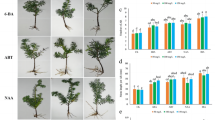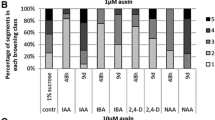Abstract
Eucalyptus globulus is the one of the most economically important trees for pulp and paper industries due to its fast growth and short harvesting cycle. However, E. globulus is well known as a woody plant that is hard to propagate vegetatively. In this study, we found wide distribution of rooting ability among seven independent genotypes we tested. Analysis of the mechanism of adventitious rooting by using the auxin transport inhibitor, N-naphthylphthalamic acid, revealed that polar auxin transport is crucial in root formation. The gravitropism of the stem was highly correlated to the percentage of adventitious root formation. Hormonal analysis showed that the levels of indole-3-acetic acid (IAA) were the same between difficult-to-root and easy-to-root genotypes, whereas levels of IAAsp (indole-3-acetyl aspartic acid) were higher in the difficult-to-root genotype, indicating that IAA metabolism might play an important role in adventitious root formation in this species. Levels of several cytokinins exhibited differences between genotypes that varied in their cutting performance and rooting ability. Furthermore, higher level of cytokinin in elongating shoots were correlated with rooting percentage. Taken together, our results indicate that both auxins and cytokinins play a role in adventitious root formation in E. globulus, and that a complex interplay between the levels of auxins and cytokinins and their metabolism might result in root formation in this commercially important plant.






Similar content being viewed by others
Abbreviations
- BA:
-
6-Benzyl amino purine
- IAA:
-
Indole-3-acetic acid
- IAAsp:
-
Indole-3-acetyl aspartic acid
- IBA:
-
Indole-3-butyric acid
- NPA:
-
N-1-naphthylphthalamic acid
References
Barlier I, Kowalczyk M, Marchant A, Ljung K, Bhalerao R, Bennett M, Sandberg G, Bellini C (2000) The SUR2 gene of Arabidopsis thaliana encodes the cytochrome P450 CYP83B1, modulator or auxin homeostasis. Proc Natl Acad Sci USA 97:14819–14824
Blakesley D (1994) Auxin metabolism and adventitious root formation. In: Davis TD, Hassig BE (eds) Biology of adventitious root formation (basic life sciences 62). Plenum Press, New York, pp 143–154
Boerjan W, Cervera MT, Delarue M, Beeckman T, Dewitte W, Bellini C, Caboche M, Van Onckelen H, Van Montagu M, Inzé D (1995) Superroot, a recessive mutation in Arabidopsis, confers auxin overproduction. Plant Cell 7:1405–1419
Da Rocha Correa L, Troileis J, Mastroberti AA, Mariath JEA, Fettt-Neto AG (2012) Distinct modes of adventitious rooting in Arabidopsis thaliana. Plant Biol 14:100–109
De Klerk GJ, Van der Krieken W, De Jong JC (1999) The formation of adventitious roots: new concepts, new possibilities. In Vitro Cell Dev Biol-Plant 35:189–199
De Smet I, Signora L, Beeckman T, Inzé D, Foyer CH, Zhang H (2003) An abscisic acid-sensitive checkpoint in lateral root development of Arabidopsis. Plant J 33:543–555
Delarue M, Prinsen E, Onckelen HV, Caboche M, Bellini C (1998) Sur2 mutations of Arabidopsis thaliana define a new locus involved in the control of auxin homeostasis. Plant J 14:603–611
Eldridge K, Davidson J, Harwood C, Van Wyk G (1993) Eucalypt domestication and breeding. Oxford Science, Oxford, p 288
Epel BL, Warmbrodt RP, Bandurski RS (1992) Studies on the longitudinal and lateral transport of IAA in the shoots of etiolated corn seedlings. J Plant Physiol 140:310–318
Epstein E, Lavee S (1984) Conversion of indole-3-butyric acid to indole-3-acetic acid by cuttings of gravepine (Vitis vinifera) and olive (Olea europea). Plant Cell Physiol 25:697–703
Fett-Neto AG, Fett JP, Goulart LWV, Pasquali G, Termignoni RR, Ferreira AG (2001) Distinct effects of auxin and light on adventitious root development in Eucalyptus saligna and Eucalyptus globulus. Tree Physiol 21:457464
Friml J, Wisniewska J, Benkova E, Mendgen K, Palme K (2002) Lateral relocation of auxin efflux regulator PIN3 mediates tropism in Arabidopsis. Nature 415:806–809
Fujita H, Syono K (1996) Genetic analysis of the effect of polar auxin transport inhibitors on root growth in Arabidopsis thaliana. Plant Cell Physiol 37:1094–1101
Fukaki H, Fujisawa H, Tosaka M (1996) Gravitropic response of inflorescence stems in Arabidopsis thaliana. Plant Physiol 110:933–943
Garrido G, Guerrero JR, Cano EA, Acosta M, Sanchez-Bravo J (2002) Origin and basipetal transport of the IAA responsible for rooting of carnation cuttings. Physiol Plant 114:303–312
Geiss G, Gutierrez L, Bellini C (2009) Adventitious root formation: new insights and perspectives. In: Beekman T (ed) Root development. Oxford Wiley-Blackwell, Oxford, p 376
Gutierrez L, Bussell JD, Pacurar DI, Schwambach J, Pacurar M, Bellini C (2009) Phenotypic plasticity of adventitious rooting in Arabidopsis is controlled by complex regulation of AUXIN RESPONSE FACTOR transcripts and microRNA abundance. Plant Cell 21:3119–3132
Haga K, Iino M (2006) Asymmetric distribution of auxin correlates with gravitropism and phototropism but not with autostraightening (autotropism) in pea epicotyls. J Exp Bot 57:837–847
Kevers C, Hausman JF, Faivre-Rampant O, Evers D, Gaspar T (1997) Hormonal control of adventitious rooting: progress and questions. J Appl Bot 71:71–79
Kojima M, Kamada-Nobusada T, Komatsu H, Takei K, Kuroha T, Mizutani M, Ashikari M, Ueguchi-Tanaka M, Matsuoka M, Suzuki K, Sakakibara H (2009) Highly sensitive and high-throughput analysis of plant hormones using MA-probe modification and liquid chromatography–tandem mass spectrography: an application for hormone profiling in Oriza sativa. Plant Cell Phyiol 50:1201–1214
Kuroha T, Satoh S (2007) Involvement of cytokinins in adventitious and lateral root formation. Plant Root 1:27–33
Li SW, Xue L, Xu S, Feng H, An L (2009) Mediators, genes and signaling in adventitious rooting. Bot Rev 75:230–247
Ludwig-Muller J (2000) Indole-3-butyric acid in plant growth and development. Plant Growth Regul 32:219–230
Moore I (2002) Gravitropism: lateral thinking in auxin transport. Curr Biol 12:R452–R454
Nagae S, Takamura T, Tanabe T, Murakami A, Murakami K, Tanaka M (1996) In vitro shoot development of Eucalyptus citriodora on Rockwool in the film culture vessel under CO2 enrichment. J For Res 1:227–230
Normanly J, Slovin JP, Cohen JD (1995) Rethinking auxin biosynthesis and metabolism. Plant Physiol 107:323–329
Sorin C, Bussell J, Camus I, Ljung K, Kowalczyk M, Geiis G, Mckhann H, Mckhann H, Garcion C, Vaucheret H, Sandberg G, Bellini C (2005) Auxin and light control of adventitious rooting in Arabidopsis require ARGONAUTE1. Plant cell 17:1343–1359
Staswick PE, Serban B, Rowe M, Tiryaki I, Maldonado MT, Maldonado MC, Suza W (2005) Characterization of an Arabidopsis enzyme family that conjugates amino acids to indole-3-acetic acid. Plant Cell 17:616–627
Swarup R, Kramer EM, Perry P, Knox K, Leyser HMO, Haseloff J, Beemster GTS, Bhalerao R, Bennett MJ (2005) Root gravitropism requires lateral root cap and epidermal cells for transport and response to a mobile auxin signal. Nat Cell Biol 7:1057–1065
Zelena E, Fuksova K (1991) The effect of indole-3-acetylaspartic acid on adventitious root formation on bean cuttings. Plant Growth Regul 10:73–78
Zhao Y, Christensen SK, Fankhauser C, Cashman JR, Cohen JD, Weigel D, Chory J (2001) A role for flavin monooxygenase-like enzymes in auxin biosynthesis. Science 291:306–309
Acknowledgments
We thank Toshiaki Tanabe, Keiichi Shimizu, Noriko Kumazawa, Eiji Iwata, Kazunori Hayashi and Chris Schiller for technical help.
Author information
Authors and Affiliations
Corresponding author
Rights and permissions
About this article
Cite this article
Negishi, N., Nakahama, K., Urata, N. et al. Hormone level analysis on adventitious root formation in Eucalyptus globulus . New Forests 45, 577–587 (2014). https://doi.org/10.1007/s11056-014-9420-1
Received:
Accepted:
Published:
Issue Date:
DOI: https://doi.org/10.1007/s11056-014-9420-1




